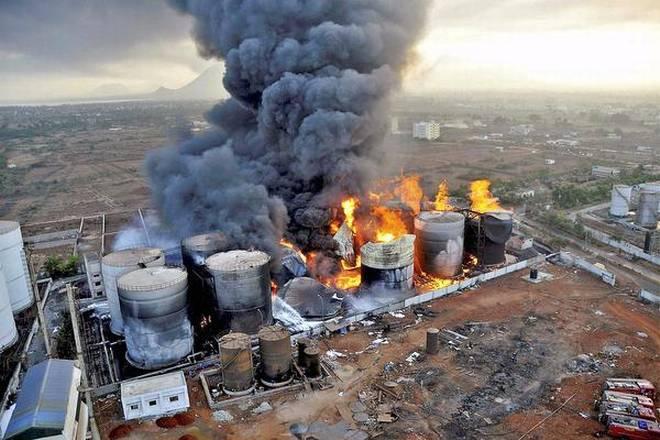162 Workers Died in Industrial Accidents in India in 2021

IndustriALL Global Union has blamed the rising deaths on relaxed inspections and licensing by the government.

New Delhi: More than 162 workers died in industrial accidents last year highlighting the soaring cases of accidents in industrial and commercial establishments in recent years.
According to Geneva-based IndustriALL Global Union—which represents more than 50 million workers in 140 countries in the mining, energy and manufacturing sectors—an average of seven accidents reported per month in 2021 also resulted in permanent disabilities and severe injuries.
A number of accidents in the first few weeks of this year shows that the worrying trend is “likely to continue,” the union added.
On 1 January, four workers died in an explosion at a fireworks factory in Virudhunagar district of Tamil Nadu.
In less than a week later, six workers were killed and 29 other employees of Vishwaprem Mill, a textile dyeing and printing factory in Surat, Gujarat, had to be hospitalised after inhaling toxic gas from the Sachin creek. On January 11, 20 employees of a fish processing unit were admitted to a private hospital in Mukka, Karnataka, following another chemical leak.
The incidents—cited by IndustriALL in its Friday’s statement—along with last year’s concerning figures, suggest that industrial accidents continue to remain a constant feature of working life in India, the federation said.
Giving possible reasons for the prevailing dangerous situation for workers at factories, the union lamented: “In the last five years, the government has relaxed inspections and licensing to allow self-certification and has exempted some companies from reporting on health and safety to ease business and support small enterprise. Low investment in health and safety, old and decrepit machinery and a lack of training for operating machinery [also] adds to the danger to workers.”
Besides, the availability of health and safety inspectors is low in comparison to the density of factories in India, where effective implementation of occupational safety standards has been a long pending demand of unions and workers, IndustriALL added.
“We are saddened and outraged by these accidents and this clearly shows serious lapses in the safety measures. We demand a high-level judiciary inquiry looking into these frequent accidents, a strict inspection of factories and mines in coordination with workers’ representatives, health and safety laws must be strengthened and implemented in true spirit and complete abolition of the contract system,” G Sanjeeva Reddy, executive committee member, IndustriALL, said.
Kemal Ozkan, assistant general secretary, IndustriALL urged the government “to urgently review the existing safety laws and rules in the country and develop an integrated action plan with the help of the trade unions to ensure that workplaces are safe and fire-proof, and not a death trap”.
Last year, the Union labour ministry informed Parliament that, at least, 6,500 employees died on duty at factories, ports, mines, and construction sites in the last five years with over 80% of the fatalities reported in factory settings between 2014 and 2018. Factory deaths rose by 20% between 2017 and 2018.
The major reasons for these ‘occupational deaths’ include, among others, explosion, fire, prime movers, machinery moved by mechanical powers, accident due to motor vehicles at construction site and electrocution, the ministry had said. A significant number of such deaths were reported from the top industrialised states, including Gujarat, Maharashtra and Tamil Nadu, the data further revealed.
Much like union leaders, labour experts—who contend that the official figures are often underreported—have argued for long that the rise in industrial accidents is correlated to the dilution of industrial labour and safety regulations that the Central and the state governments have undertaken over the years under the garb of boosting the country’s rank in the World Bank’s global index of Ease of Doing Business.
Besides, the availability of health and safety inspectors is low in comparison to the density of factories in India, where effective implementation of occupational safety standards has been a long pending demand of unions and workers, IndustriALL added.
“We are saddened and outraged by these accidents and this clearly shows serious lapses in the safety measures. We demand a high-level judiciary inquiry looking into these frequent accidents, a strict inspection of factories and mines in coordination with workers’ representatives, health and safety laws must be strengthened and implemented in true spirit and complete abolition of the contract system,” G Sanjeeva Reddy, executive committee member, IndustriALL, said.
Kemal Ozkan, assistant general secretary, IndustriALL urged the government “to urgently review the existing safety laws and rules in the country and develop an integrated action plan with the help of the trade unions to ensure that workplaces are safe and fire-proof, and not a death trap”.
Last year, the Union labour ministry informed Parliament that, at least, 6,500 employees died on duty at factories, ports, mines, and construction sites in the last five years with over 80% of the fatalities reported in factory settings between 2014 and 2018. Factory deaths rose by 20% between 2017 and 2018.
The major reasons for these ‘occupational deaths’ include, among others, explosion, fire, prime movers, machinery moved by mechanical powers, accident due to motor vehicles at construction site and electrocution, the ministry had said. A significant number of such deaths were reported from the top industrialised states, including Gujarat, Maharashtra and Tamil Nadu, the data further revealed.
Much like union leaders, labour experts—who contend that the official figures are often underreported—have argued for long that the rise in industrial accidents is correlated to the dilution of industrial labour and safety regulations that the Central and the state governments have undertaken over the years under the garb of boosting the country’s rank in the World Bank’s global index of Ease of Doing Business.


Very good data and more informative awareness over safety and safe workplace to sustain..
The action plan to cover to prevent the Accidents on priority will help all people to maintain Safety on higher angle.